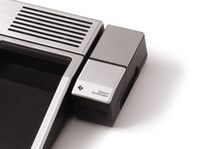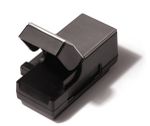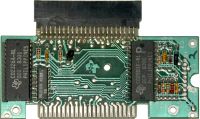TI-99 sidecar expansion
The TI-99 sidecar expansion components were originally released to provide expansion capability to the TI-99/4. Several expansion devices were designed, though not all were released commercially. At least one, the P-Code Peripheral, may be vapor ware. Each of the devices, with the exception of the Disk Controller, allows the bus to pass through to additional peripherals. TI rethought their expansion strategy when the FCC tightened RFI requirements at the beginning of 1982. The train of peripherals did not meet the requirements for an FCC Class B device, and so most of them were discontinued in favor of the PEB.
Speech Synthesizer
The TI Speech Synthesizer was also the only device that remained in side-car position and did not move into the PEB. This allowed users which did not want to expand their system with a PEB to enjoy speech synthesis. Moreover, the synthesizer is comparatively small. The Speech Synthesizer always has to be the closest peripheral device to the console because it draws power through the computer's expansion port.
Interestingly, the synthesizer device provided a lid which could be opened - just to find nothing in there. In fact, earlier designs of the Speech Synthesizer included an extension port which allowed speech cartridges to be plugged into the device, just like the cartridges for the console, but much smaller. It seems as if TI just decided to keep the containment, and left away the socket on the synthesizer board.
The option to extend the vocabulary by modules never materialized, as TI found an easier solution using the Speech Editor cartridge, the Terminal Emulator II cartridge, or the Text-to-Speech disk. All three of these methods allowed nearly unlimited vocabulary. None of the planned Speech modules ever made it into production, and no surviving prototypes are known.
From third party, speech synthesizer adaptor cards were offered which allowed to move the synthesizer into the PEB after all, using, for example, a CorComp Triple-Tech card or a Rave Speech Adapter. This is also mandatory for Geneve or TI-99/4P users as they do not have any console to attach the Synthesizer to. The circuit board had to be removed from the chassis of the Synthesizer.
Near the end of Texas Instruments' engagement in the Home computer market, the Speech Synthesizer was packed with cartridges making use of the synthesizer hardware, making it probably one of the most popular pieces of hardware. Many people rushed out to purchase as many modules they could while they still had the free speech synthesizer offer available.
More information about the processor used by the Speech synthesizer can be found in the internals section.
RS-232 Expansion
This peripheral adds a pair of RS-232C ports to the computer. No provision is made for parallel devices. It has its own power supply and can be placed anywhere in the peripheral chain after the Speech Synthesizer and before the Disk Controller.
32K Memory Expansion
This peripheral adds 32K of 8-bit CPU memory to the computer. It has its own power supply and can be placed anywhere in the peripheral chain after the Speech Synthesizer and before the Disk Controller. It requires specialized software to access it, as it is not recognized by TI BASIC. Several cartridges make use of the additional memory: TI Extended BASIC, TI Writer, TI Multiplan, Editor Assembler, Mini Memory, and both versions of TI LOGO (I and II).
HexBus Interface
The TI HexBus Interface was effectively the last peripheral device TI specifically developed for the TI-99/4A. Other items were in development at the same time, but they could be used with both the TI-99/4A and the TI-99/8. It added the capability to connect HexBus peripheral devices while allowing concurrent connection with a PEB. Unfortunately, TI withdrew from the home computer market before the device went into serial production, so only a few prototype devices survive. The HexBus Interface was eventually reverse-engineered by TI enthusiasts in Germany, though they also only produced a few of their HexBus Interface clones (the last count stood at three, though they were willing to produce more).
Single-Density Floppy Disk Controller
This peripheral adds the capability to connect up to three Single-Sided, Single-Density (SSSD) disk drives to the computer. It has its own power supply and must always be the last peripheral in the peripheral expansion chain. The disk drives can be formatted as either 35 or 40 tracks of nine sectors each. As 35-track drives were no longer standard at the time it was released, all known disks used the 40-track format.
Video Controller
The Video Controller allowed connection of several models of videotape recorders and laser disk players to be connected to the TI-99/4A. It was designed to allow interactive instruction using a combination of computer software running on the machine and video instruction materials retrieved from the tape or laser disk as part of the lesson. The Video Controller was listed on TI price lists in 1981, but the device failed the necessary FCC certification, and so could not be sold to consumers. It could be used in industrial environments, but was apparently never put into production for that market. Only a few prototypes survive. It maintains full forward compatibility with the Video Controller Card for the PEB.
Thermal Printer
TODO
GROM Box
TODO



